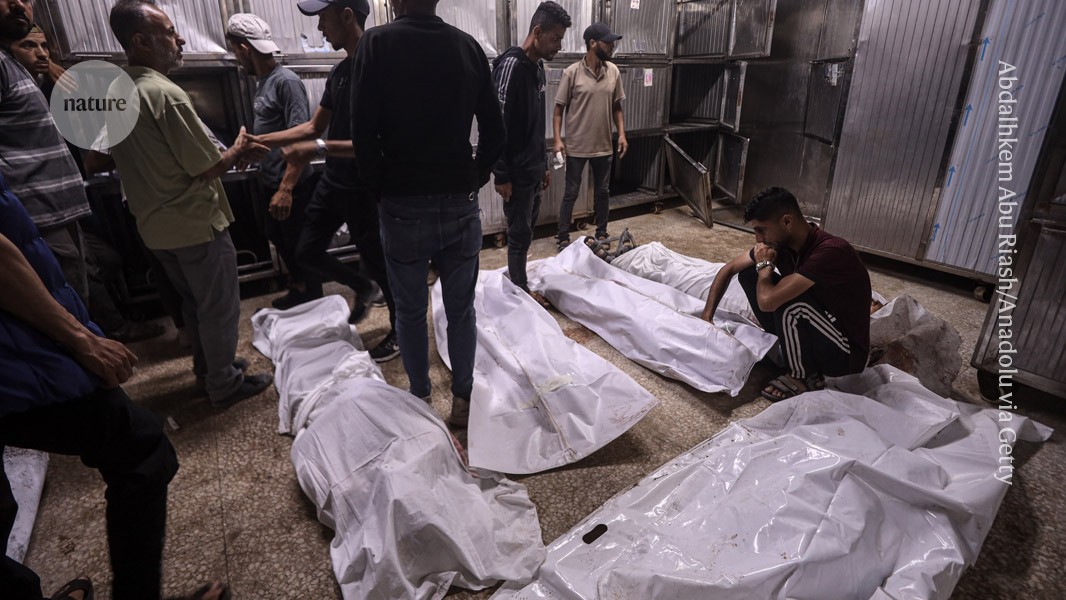
It has been difficult to gather reliable estimates of deaths during the war in Gaza.Credit: Abdalhkem Abu Riash/Anadolu via Getty
Almost 84,000 people died in Gaza between October 2023 and early January 2025 as a result of the Hamas–Israel war, estimates the first independent survey of deaths. More than half of the people killed were women aged 18–64, children or people over 65, reports the study, which was posted on the preprint server medRxiv last week1. It has not been peer reviewed.
Since the start of the war, the Palestinian Ministry of Health — Gaza has been the main institution counting mortality in the region: it regularly publishes detailed lists of people who have died. The most recent count, on 25 June, reported 56,200 deaths. But some people have questioned the reliability of the ministry’s figures — and studies based on them — particularly as the conflict has progressed and medical centres, which the ministry relies on for its mortality data, have come under attack.
The latest figures do not rely on ministry data but could contain uncertainties given the challenges of counting fatalities in a conflict zone. But the numbers are similar to those reported by another research group, who used a different counting method, earlier this year, says Patrick Ball, a statistician and director of research at the non-profit Human Rights Data Analysis Group in San Francisco, California. That increases Ball’s confidence in the latest work.
Independent survey
To conduct an independent survey of fatalities, researchers worked with the non-profit Palestinian Center for Policy and Survey Research, based in Ramallah, to survey randomly selected households representative of the population across the Gaza Strip. This included people living in makeshift shelters and tents. The survey team was not able to enter Northern Gaza, Gaza City or Rafah owing to active conflict and evacuation orders, but many people living in those areas have fled to the surveyed areas.
Over a week, starting on 30 December 2024, pairs of surveyors visited 2,000 households and interviewed adults. Respondents, who were granted anonymity, were asked to list how many individuals were in their household on 6 October 2023 and children who had been born since then, and then to report the fate of all household members since then as alive, dead or missing. For those who had died, respondents were asked to clarify whether they had died of violent or non-violent causes.
“The strength of this comes from the fieldwork,” says Ball, who found it extraordinary that the team was able to do such a detailed survey amid the conflict.
Violent and non-violent deaths
The researchers estimate that in the 15 months up to 5 January, there were around 75,200 violent deaths in Gaza. Another 8,540 people died of non-violent causes as a result of the war.
But there could have been more non-violent deaths since the survey was conducted, says study co-author Michael Spagat, an economics researcher at Royal Holloway, University of London, in Egham. The health status of Palestinians and their access to health care was good before the war, but that has probably changed as the conflict has dragged on, says co-author Debarati Guha-Sapir, an epidemiologist who specializes in civil conflicts at the University of Louvain in Louvain-la-Neuve, Belgium, and is based in Brussels.
Six months have passed since the survey was conducted, but that doesn’t diminish its relevance, says Laith Jamal Abu-Raddad, an infectious-disease epidemiologist at Weill Cornell Medicine-Qatar in Doha. “On the contrary, it remains timely, as the crisis persists — and has arguably intensified over the past three months.”
A two-month ceasefire between Hamas and Israel ended on 18 March. Since then, critical infrastructure, including hospitals, has been severely damaged on the Gaza Strip; hundreds of thousands of people have been displaced from their homes; and humanitarian aid has been restricted.
Different methods
The latest count aligns with an estimate of 64,260 violent deaths up to the end of June 2024, reported2 earlier this year by another research team.
That work, led by Zeina Jamaluddine, an epidemiologist at the London School of Hygiene & Tropical Medicine, used a method known as capture–recapture analysis, in which the overlap between multiple lists of fatalities is used to calculate mortality. Jamaluddine and her colleagues used health-ministry data and other sources.


